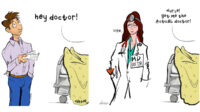Optimal Team Practice – sounds like a pretty straightforward, understandable phrase that all of us in healthcare should be able to get behind. Medicine is becoming more siloed and specialized over time. While this is great for patients, it means all clinicians need to work together more closely than ever to ensure good outcomes for patients. The days of the ‘lone wolf practitioner’ are more or less behind us, and it’s time for healthcare to catch up.
What is Optimal Team Practice?
So what is Optimal Team Practice (OTP)? And how exactly do we achieve optimal practice as a medical team?
OTP, as we’ll discuss here, is a resolution by the PA (physician assistant) profession to further contribute to patient care and reduce the administrative burden on both PAs and physicians. I don’t know about you, but anytime someone wants to reduce my administrative headaches, I’m all for it. Now if only we could get rid of all the other administrative bloat, we’d be all set. Ultimately, OTP is for improving patient care in multiple ways.
Not Just For PAs, It’s For All Clinicians
Before we get into it, let’s identify who exactly this article is for. Despite OTP being a PA resolution, this article is not primarily intended for PAs. Instead, clinicians – especially physicians, NPs, pharmacists, nurses, and yes, even administrators, especially those who have never heard the term or find it controversial, would benefit from reading this post.
I’m going to try my darndest to present a factual, apolitical, and as unbiased of a view as possible of what OTP is and why you should care. That said, we won’t discuss unscientific anecdotes where a patient saw a specific type of clinician and suffered a poor outcome. In healthcare, we all live in glass houses, and anecdotes aren’t evidence.
I’m going to level with you. I’m a PA and I want you to support OTP, especially if you work with PAs. However, I’m not going to rhetorically twist your arm to get you to agree with me. Lastly, I’m only speaking on my own behalf here; I’m not representing any institution with which I am or have been associated, including the PA profession at large.
Definition of Optimal Team Practice
According to the American Academy of PAs (AAPA), Optimal Team Practice (OTP) occurs “when PAs, physicians, and other healthcare professionals work together to provide quality care without burdensome administrative constraints.” For anyone who chose medicine as a career, that’s the dream, right?
One goal of OTP is to align decades-old legislation with current practice standards, reduce the bureaucratic and legal burden that comes with a PA having a state-mandated relationship with a specific physician, and have PAs take full responsibility for their work like any profession should.
PAs have been around for 55 years; however, legislation has not kept up with advances in clinical practice. If you think carrying a pager is outdated, our current legislation makes that beeper look like the latest iPad. Not only that, but it is highly variable from state to state. As a fellow clinician, you know that politics is not primarily evidence-based, so it is hard to justify this variability scientifically.
A substantial part of professional practice that OTP addresses is regulation by a board of your peers. Almost every other healthcare profession is afforded this right, except for PAs. OTP encourages PA-specific boards (or the addition of PAs to existing medical boards) at the state level to regulate the profession.
“A substantial part of professional practice that OTP addresses is regulation by a board of your peers. Almost every other healthcare profession is afforded this right, except for PAs.”
It would only make sense to have a regulatory body made up of people who understand the rigor of your education, your abilities, clinical skills and limitations, and how the profession is advancing. So why then aren’t PAs regulating their own profession? Nothing against other healthcare professions, but imagine podiatrists running the board of optometry. That’s essentially what’s happening now.
The reduction in bureaucratic and medical legal liability for physicians and PAs is probably the most important component of OTP. I come from a family of medical malpractice attorneys, so you can bet that if a PA is sued, so too will their physician. And there are no winners in such a suit, just a loser and a bigger loser.
“The reduction in bureaucratic and medical legal liability for physicians and PAs is probably the most important component of OTP.”
This is at the heart of another significant barrier to the optimal utilization of PAs – the requirement to have a relationship with a specific physician. Back before healthcare was overtaken by a few conglomerates, this made sense, both from a business and clinical perspective. However, as more physicians become employed, and now more physicians are employees than practice owners, this unfairly shifts the risk to them, often without a comparable benefit.
What OTP Means For The Physician-PA Team
PAs are trained and ready to take responsibility for their work. We always have been. Physician assistants are trained as general medical practitioners through an allopathic medical model. PAs do a year of clinical rotations through all major medical specialties and sit for a national licensing examination. PAs do the same CME as physicians and NPs. Like other health professions, PAs are also trained to know their limits and when to refer a patient to a more experienced or specialized clinician.
This is not about throwing new graduate PAs out into the wild to clinically fend for themselves. No new graduate clinician, no matter the degree, is ready for that. OTP proposes that this relationship be built at the practice level, not mandated by the state.
When a clinician needs help or a consult, that decision should stay at the practice level. Clinical experience and postgraduate education should and do allow PAs much more autonomy than they are currently afforded under state practice acts. After all, who understands their care model better than the clinician leadership at the practice themselves?
Lastly, because of COVID-19, governors from eight states have waived supervisory or collaborative requirements for PAs since early 2020. These states join two others that have legislatively ended these barriers since 2018. And evidence shows that because of these much-needed emergency orders, patients have benefited from having more highly trained medical professionals who otherwise would have been forced to the sidelines during this pandemic.
Learn More About OTP
There is more to OTP than what is covered here. I encourage you to visit these additional resources created by the AAPA to learn more.





